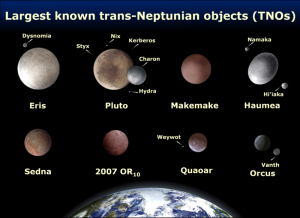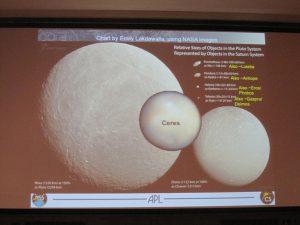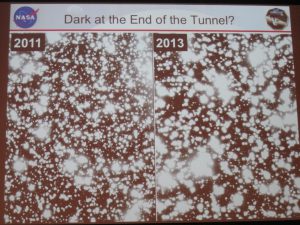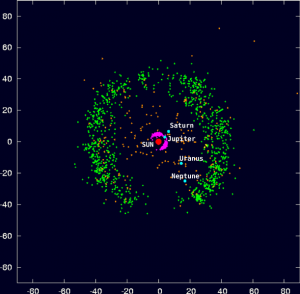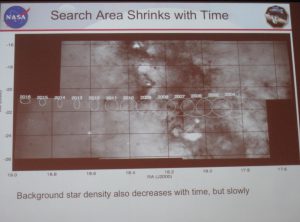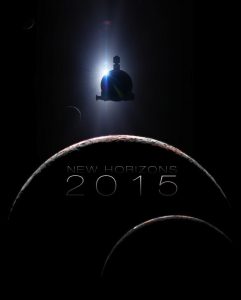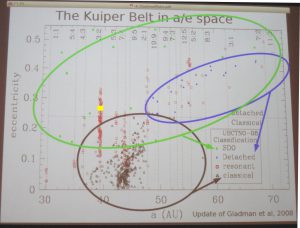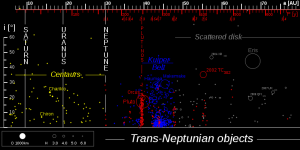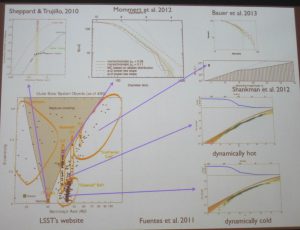Reposted from https://blogs.nasa.gov/mission-ames/2013/07/23/comparative-compositions-of-pluto-and-friends-even-long-distant-friends/.
Continuing coverage of the July 22, 2013 first day of the Pluto Science Conference being held this week in Laurel, MD.
Bill McKinnon (Washington University) next provided an engaging talk about implications for composition and structure for Pluto and Charon.
Where did Pluto Accrete (i.e. where was Pluto born)? Pluto is not alone in its location on that a/e plot for Trans-Neptunian Objects (see previous posting). It’s part of an ensemble of bodies on the 2:3 resonance with Neptune, coined the group “Plutinos.” Was Pluto formed around 33 AU (Malhotra 1993, 1995) and then migrated outward? What does this Nice I Model (Levinson et al 2008) which migrates the giant planets predict for the KBO population? The Nice I Model implies that for Pluto, Pluto could have formed 20-29 AU (i.e. closer in) to allow it to achieve its high inclination. Then a subsequent model, Nice II (Levinson et al 2011), suggests Pluto may have formed in the 15-34 AU range. This is in okay-agreement with accretion models since Pluto, a 1000-km size body, would need 5-10 million years (i.e. within a nebular life) if it were formed in the 20-25 AU range. McKinnon’s best guess: Pluto formed between 15-30 AU.
How long did accretion take and what are the implications (i.e. how long for Pluto to grow up)? If we have an accretion time (10’s of million years), there is time enough to form Aluminum-26, which provides a form of heat through its decay. Heat then can melt ices and create a differentiated body (i.e., rocky core, icy mantle) and also drive water out. McKinnon’s best guess: Pluto formed rapidly and early.
What are Pluto & Charon made of? They are understood to be made of rock+metal, volatile ices, and organics, with rock+metal more than ice, and ice more than organics. The rock will be some combination of hydrated & anhydrous silicates, sulfides, oxides, carbonates, chondrules, CAIs (calcium-aluminum-rich inclusions), CHONPS (carbon, hydrogen, nitrogen, oxygen, phosphorus, and sulfur). We don’t really know what sort of composition these KBO volatile ices: will they be more like Jupiter Family Comets or Oort Comets? And we know even less about organic components: will the Nitrogen to Carbon ratio tell us whether KBO N2 (nitrogen) comes from organics rather than NH3 (ammonia)? Solar models (which lock up CO (carbon-monoxide) into carbon) can influence understanding of what rocks in the outer solar system are made of but their models are not in agreement with the best understanding of Pluto/Charon make-up. McKinnon’s best guess: Rock/Ice nature of Pluto-Charon is 70/30.
What are the implications for Pluto & Charon internal structure? New Horizons will not directly detect the differentiation state of Pluto & Charon because it does not fly close enough.
Alain Doressoundiram (Paris, France) came next. Using MIOSTYS, multi-fiber front-end to a fast EMCCD camera, on a 193 cm telescope in France, they observe outer solar system bodies using stellar occultations. Other science objectives for variable stars, transiting exoplanets. They confirmed two TNO occultation events, one in 2009 and one in 2012 and continue monitoring.
Luke Burkhart (Johns Hopkins University) talked about his work on a “Non-linear satellite search around Haumea.” Haumea is another Trans-Neptunian Object (TNO) that has multiple satellite companion, like Pluto. Using HST (10 orbits) they observed the Haumea system and used a method of stacking & shifting to identify satellites. But this method fails to capture objects which are close in, moving fast, and on highly curved orbits. So they developed a new method using a non-linear shift-rate. Their approach, when applied to the Haumea system, had a null-result. However, this approach could be used on images of the Pluto system and other TNOs. Specifically, in answer to a question from the audience, Luke would be eager to use his technique on any of those long-range KBO targets the New Horizons project is currently investigating.
Family portraits of the eight largest trans-Neptunian objects (TNOs) (From http://en.wikipedia.org/wiki/Trans-Neptunian_object). Pluto is shown with its 5 companions.
Andy Rivkin (JHU/APL) ended the afternoon’s lively discussion by addressing “Distant Cousins: What the Asteroids Can Teach us About the Pluto System”. He started his talk with a comparison of sizes between Ceres (the largest asteroid in the asteroid belt between Mars and Jupiter) and the Pluto System. He used as his framework Emily Lakdawalla’s chart, which can be found on the Planetary Society blog http://www.planetary.org/multimedia/space-images/charts/relative-sizes-pluto-system.html.
Here the relative sizes of objects in the Pluto system are represented by objects from the Saturn system. Saturn’s moon Rhea serves as Pluto, Dione as Charon, Prometheus as Nix, Pandora as Hydra, Helene as Kerberos, and Telesto as Styx. Superimposed is where Ceres (an asteroid in our asteroid belt between Jupiter & Mars) fits on this scale. Andy Rivkin did a comparison of his observations of Ceres to postulate what that might mean for the Pluto system.
Pluto system and Ceres shown to scale, represented by objects from the Saturn system.
Ceres has an icy interior, but much too warm to keep ice on surface. HST images reveals rather smooth surface. IR spectra (from reflected sunlight) are very rich and indicative of ice-type features. Could there some sort of layering? On Pluto, you could have the same thing, but it’s also cold enough for ice to remain on the surface. There is also a mystery that several large C asteroids have similar 3 micron spectra to Ceres like 10 Hygiea and 704 Interamnia.
Implications for Pluto: Large main-belt asteroids could serve as comparisons for KBOs. Geophysical comparisons may be easier than compositional ones.
So the big take-away from the introductory talks on the “Kuiper Belt Context” is that we can learn more by sharing the knowledge: Learning from Other Bodies (Other TNOs, Comets, Asteroids) will help us learn more about Pluto & Charon, and vice versa.

